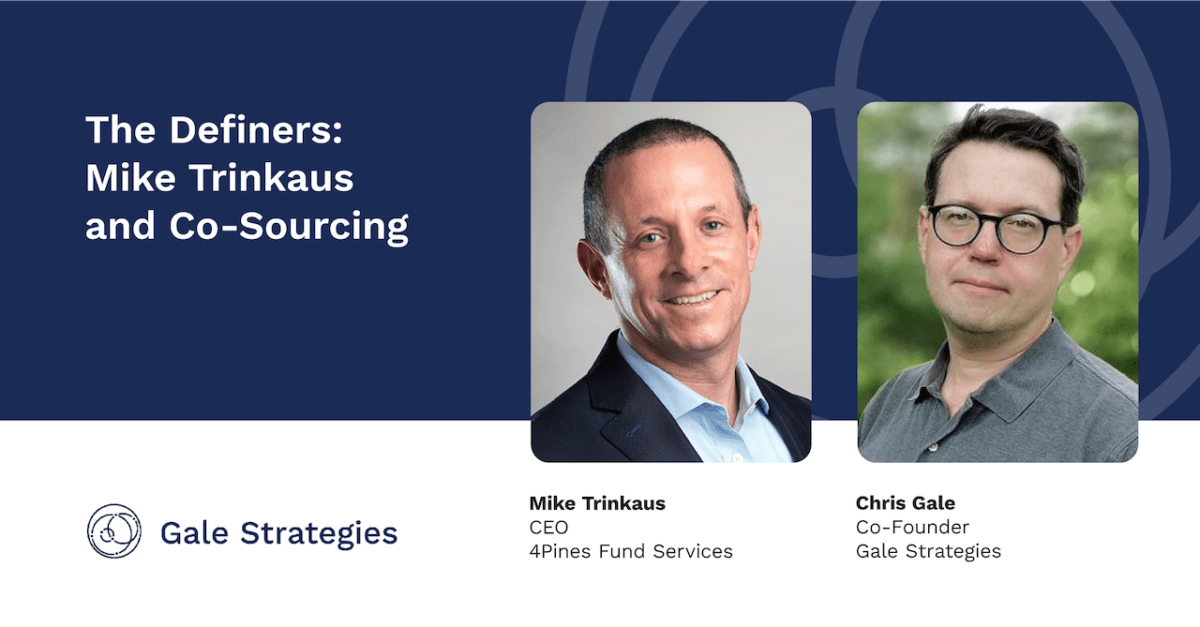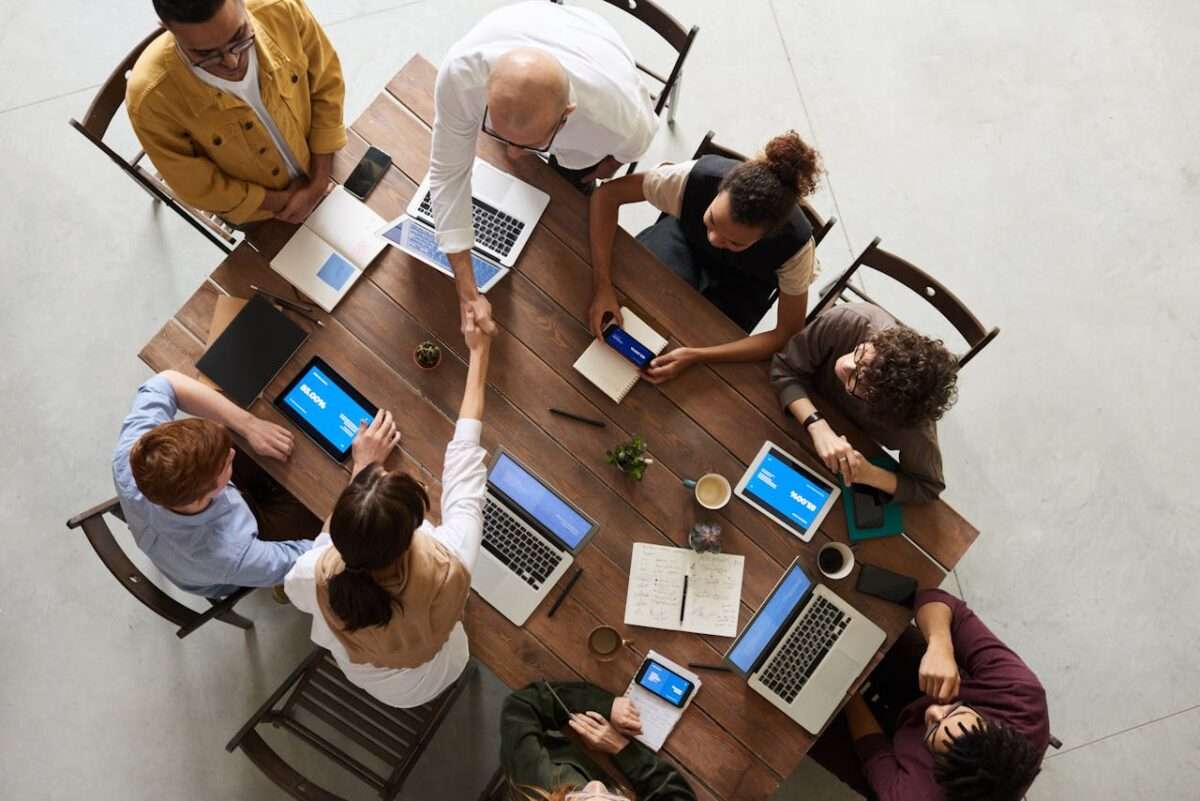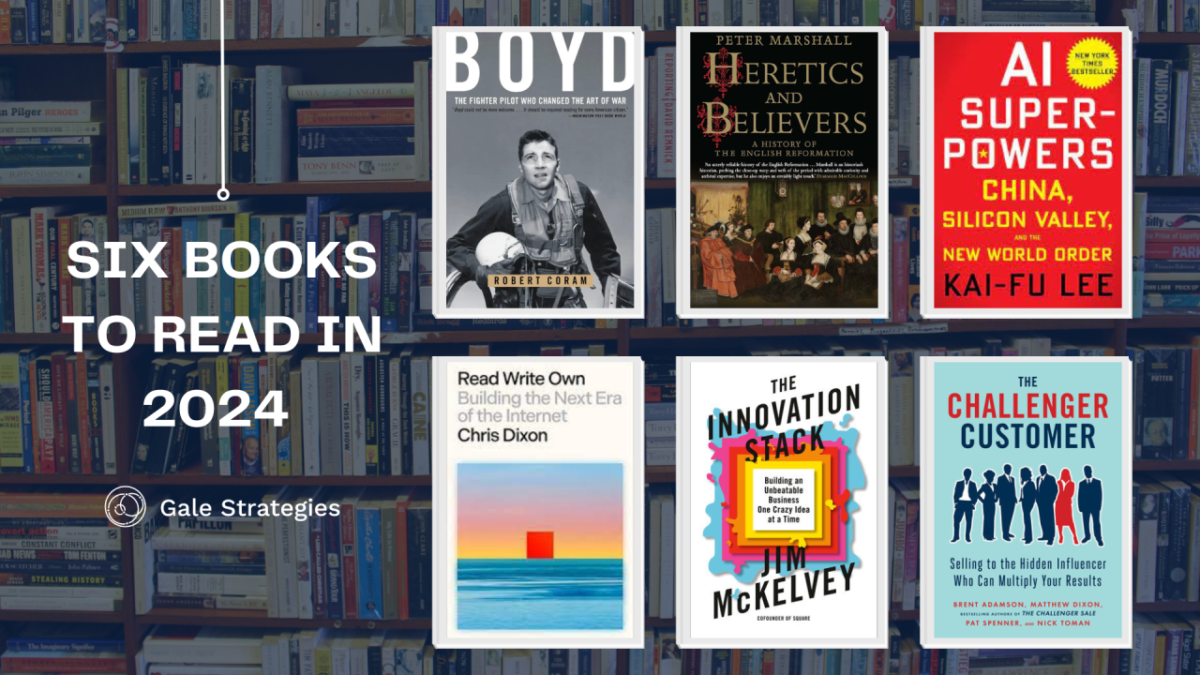Mike Trinkaus and his team have defined what “co-sourcing” means in fund services. Category creators and those on their way to being one are joining us March 26th to find out what makes 4Pines Fund Services so successful in what they do. We’ll ask Mike why other fund administrators are reluctant to take up co-sourcing in the same way his team does, why it’s a winning formula for 4Pines, and what the innovation stack they’re building looks like to better serve their clients.
Chris Gale 00:02
This is the second episode of our series here at Gale Strategies, the Definers. I’m super excited to have Mike Trinkaus here, our client at 4Pines Fund Services. We call the series the Definers because we love to work for companies and individuals that are actively defining the future of their particular industry or an aspect of their industry. What we mean by that is: pursuing a business model – disruption is an old and maybe tired word – that’s changing the industry. Then, because we’re marketing and communications folks, leading the industry actively in the thought leadership of not just doing the thing, but also helping to articulate and explain it and bring together a movement.
Mike here is an embodiment of what we get excited about. We find ourselves often talking to folks in our network or other clients and saying, “You should look at this guy, Mike Trinkaus, and the team at 4Pines. They’re doing something particularly interesting.” We’re going to ask Mike about that. And we’re going to zero in on one thing in particular that folks in our network have been excited about and asked us about. We’ve pointed to Mike so many times that we thought he might come on in person and explain himself instead of us being the filter.
Talking about something that your competition is unwilling to say or can’t say – fans of Hamilton Helmer may be familiar with counter positioning – there are elements of that.
Mike, I just realized. Can you do a quick intro about 4Pines?
Mike Trinkaus 02:04
Thanks for having me. I appreciate the opportunity to speak to you. I’ll first say that I’ve never thought of, certainly myself and us at 4Pines as definers or anything along those lines. But it has been a really interesting journey to watch what we’ve been able to do with you guys around certain aspects of the message that we want to get out there, and how that’s currently making its way through the market. So that is pretty exciting and I can’t wait to dig into that a little bit.
But who we are: we’re a fund administrator. We do back, middle, and front office work for venture capital firms, buyout firms in the private equity space, and secondary shops-funded funds. We do a little bit of credit in real estate, and real estate space as well. But we’re essentially a managed services firm with a little bit of a hint of a technology angle as well because we’re very, very big on and using technology in efficient and effective ways. Very big picture, that’s kind of who we are. We care about people first and foremost. And we couple that with the technology piece.
Chris Gale 03:20
Before 4Pines, you are a former CFO, and one of your cofounders, Celeste Barone, is a former CFO of portfolio advisors. Celeste, I think, came from Commonfund.
Mike Trinkaus 03:35
That’s exactly right. Essentially, we’re a group of executives who came together through a variety of different careers. Celeste and I both came from the PE industry. We both spent a number of years as CFOs in the space. Our CFO has an engineering background, did a lot of contract manufacturing, and ran global teams in his career. Our CTO is an expert in automation who came from IBM. Our head of product is a longtime fintech guy. We brought together those collective experiences to end up where we are today with this philosophy, vision, and strategy that we have at 4Pines.
Chris Gale 04:25
You are a fund administrator with a CTO, which is fascinating. Maybe I’ll come back to that in a second. The thing that you talk about that other fund administrators sometimes talk about, but not with the clarity and with the sort of bravery that 4Pines does, that’s co-sourcing. Can you explain what is co-sourcing?
Mike Trinkaus 04:55
Absolutely. Happy to do so. I do get asked that question a lot – exactly what co-sourcing means. You know, over time, I’ve started to parse this into two places. There’s this holistic definition, which is a bigger picture, a broader concept that I’ll talk about in a second. And then there’s the everyday operational piece. So let me start with the bigger picture, the holistic piece. Co-sourcing is part of a broader vision that we have around the industry in and of itself, and where we think the industry needs to go and shift towards as the market changes and as the industry changes. As you start focusing on partnering with your clients – truly collaborating with your clients and doing things that incentivizes each other to work together in the same direction – as opposed to what we’ve historically done in this space, which is, “I go behind the curtain on this side. I do the stuff I’m supposed to do. You sit on this side. You hope that I’m doing the stuff that I’m supposed to be doing. You hope that it’s right. And you hope that I meet the deadlines, without any visibility into what we’re doing at all.” We want to redefine what all of that means. As part of the redefining, of what we think the fund advisor business should be doing going forward, we’ve landed on co-sourcing.
On the operational level, the definition of co-sourcing is quite simple. We want to partner with our clients. We want to collaborate with our clients. So, one of the best ways that we think to do that is to jump into the software, the tech stack of our clients, and, in particular, their accounting technology platform. That opens up the power dynamic a bit in the relationship. Historically, firms would outsource. We would have all of their data, and it put them in a tough spot if we weren’t delivering. One of the things I said when I first got into this space was “My background is as a CFO and as an operator. How do I protect myself against that?” If you go back 10 or 11 years, we were only 30 to 35 percent outsourced as in industry. One of the things that I used to hear a lot was, “You have my data. I don’t want to do a data migration.” My initial thought was, “Okay, let’s take that off the table. Let’s talk about what co-sourcing is, and how co-sourcing can address your biggest concern that you’re giving me for not wanting to outsource.” That really started the journey of what co-sourcing means and how you define it. Very simply put, we operate on our clients’ platforms.
Chris Gale 07:58
On one hand, it’s a simple concept. But the impact of it once you go down that road – it opens up a lot of different possibilities of what you could be doing, which I want to get to further on.
To recap, the traditional model would be outsourcing. If I was the front administrator, and you were a private equity CFO, I would have the general ledger on my side. Then you have a deadline coming up, you wonder where the work is. It’s coming. But you can’t really see it. If you aren’t happy with my work because my team is changing or I’m missing deadlines, you’ve got to extract all that data. You might actually have a set of books on your side that you’re checking against the GL that’s on my side. What you’re saying is, “Now I’m going to be honest.” With co-sourcing, I’m going to be doing the work on your side. All of the value that I’m creating, all the workflow, is going to be visible to you. You know exactly where I am.
Mike Trinkaus 09:29
In a nutshell, that’s it exactly. We’re opening up what used to be a black box to our clients, the GPs, and we are saying, “Hey, the model has to change. We want to partner. We want to collaborate. We want to provide transparency to our clients because the market is changing. The needs are changing. The strategies around information and access to that information are changing the tech analogy is changing.” Ten years ago, you couldn’t do a lot of these things efficiently and effectively. Today, a lot of GPs are resetting their internal operating model around data, how they’re using it, and how they’re connecting across different platforms. In our view, we don’t want to be a problem in that process. We want to facilitate that process. We want to help move data if we need to so that you can get it to the places without downloading and uploading and using a manual process to get to where you need to be. I think you described it quite well.
Chris Gale 10:45
Why are you virtually the only one of the fund administrators talking about co-sourcing so enthusiastically? I’ve seen others quoted where it’s like, “If clients want to do it, we can do it.” But you’re an evangelizer.
Mike Trinkaus 11:01
Yes – 100 percent. One, we’ve spent a lot of time thinking about the operating model, and what it means to be a co-sourcer. I can talk about some of the challenges around it because it’s a trade-off with everything we do. Our operating model has been built and designed with the vision of this from the beginning. When we started in January 2020, what we put in place lends itself a lot more easily to a co-sourcing model. There are reasons for that. That’s why we’re so gung-ho about it.
There are two things. One, because we focused on it from day one, we can put forward an operating model that allows us to not succumb to some of the challenges of co-sourcing like the incumbents because of how their operating model is built. You know, they’re challenged on the legacy side because they’re not built for this. They are built for the old model that is closed off, that isn’t collaborative, that isn’t integrated. It doesn’t mean everybody is against co-sourcing. Some folks are reluctantly talking about it because it does make a lot of business sense and creates some business opportunities because there is a lot of interest and enthusiasm in the market for it. So, you are seeing some folks ignore their operating model to take advantage of certain business situations. But the reality is that many firms in the market – whether their legacy tech or their legacy operating model isn’t built for a co-sourcing model that is scalable – have zero incentive to push this model. Again, we’re just the opposite. We’re trying to build something from the beginning. That allows us to scale this in a meaningful way. Because that’s what our strategy has been from day one. We can do it because that’s what we’re building to do.
Chris Gale 13:13
About this idea of saying something your competition is unwilling or can’t say – if you were to say, “We’re transparent,” if Gale Strategies was working for the competition, we could say “No, we’re more transparent.” We might cough up some numbers to show that if I were working for your competition. Why would the competition say “No, we’re not talking about co-sourcing?” Can you share a little bit more about why the marketing and sales team of the competition is going to be held back? Why would they be reluctant to say something like you’re saying? Can you share more from their perspective? I realize I’m asking you to speak in your competition’s voice.
Mike Trinkaus 14:11
If I were them, I would push the conversation away from co-sourcing. They’re not built for it. Everything they’ve done – if they’ve created efficiencies, if they’ve created automation on their side – it all goes out the window in a co-sourcing relationship. That’s one of the challenges with it.
I’ll give you a perfect example. If we have an accounting platform that we’re using, we invite our clients in. We’ve created some integration with some other platforms that we’re using – LP portals, waterfall tools, etcetera, etcetera. It’s really easy to put 20 clients on that platform, and then push that data out to those different platforms that we’re using for each one of those 20 clients in a co-sourcing relationship. If I have 20 clients and they’re all co-sourcing, I now need to figure out the most efficient way to connect to those same systems through 20 different instances of that platform. The teams, in most cases with many folks in the industry, just are built and prepared for that level of work and sophistication. Concerning automation and integration, we’re constantly thinking about the best way to do that and integrate. It’s not easy, but we can do it. So that is one example of why somebody who’s an incumbent will push their marketing firms to not go all in on this co-sourcing. Again, it’s disruptive to the operating model of many folks in the industry, given they’ve been around for 10, 20, 30 years. There are legacy people. There’s legacy technology. It is turning that operating model upside down when going into a co-sourcing relationship.
Chris Gale 16:09
So, there’s a cost to be paid to do my work on your side if I’m the fund administrator. I’m more exposed. There’s a lot of systems investment, workflow investment, which like I said, I think we’ll get into. If I’ve got all this existing business that’s easier and doesn’t expose me to those things, then I’d rather try to compete against Mike on something else.
Mike Trinkaus 16:37
The reality is that there are a lot of downsides to co-sourcing when you initially look at it. But to me, that’s a short-term view of how to look at what co-sourcing can do for you and your clients. We don’t want just clients. We’re looking to form partnerships, with real collaboration. with our clients. The way we do that is, we expose ourselves a little bit. We have to say, “Hey, if we’re not doing the job we’re supposed to do if we’re not transparent about what we’re doing, how we’re doing it, and who’s doing it, isn’t that a bit unfair to our clients?” We need to stand up a little bit and sit up a little bit straighter in our chair. The reality is, if we do the job that we’re supposed to do, whether we’re co-sourcing or not co-sourcing, we’re going to have a great client. When we’re in a co-sourcing relationship, it just opens up the possibility for a stronger partnership to be strategic with how we help our clients out. It’s really up to them in many ways to drive it. But it puts us in a position to help them achieve what they’re trying to achieve. Because the finance departments continue to become more important for the GP, they need some partners on the operation side that can help them be more strategic, help them execute a better plan around data on their side. It’s really what we’re trying to do. If we do that, we’re going to end up okay, and I think we’re going to execute on our vision and our strategy of what this industry should look like.
Chris Gale 18:26
On that basis, maybe there’s a pre-agreed set of questions that I’m working through. I want to take the last question and move it next in the sequence because I think we’ve kind of danced around the workflows and the investment and all the stuff that has to be in place to make this work. That’s important, which is to say, we’re talking about it at a theoretical level.
What have you done and what needs to be done to make co-sourcing work? It sounds like the alternative could be, again, if I’m the fund manager, I could be working on your side on your software. All I can do is screw it up. It sounds like I need to have some workflows and some familiarity that I’m not going to be able to do on day one.
Mike Trinkaus 19:23
It’s certainly a journey because, in many, many instances with co-sourcing, we’ll jump into existing systems. The first thing you have to do is go in and understand what’s there to begin with. Then you need to assess what you need to fix because, oftentimes, what we see is a process that’s been developed over time for a specific firm. Yes, it works for that specific firm. But what you see is you may not have broader expertise because you do the same things over and over. We like to come in with a much more well-rounded experience within the platform. We usually can find some easy fixes in areas that can make our job easier, help the clients in the long run, create some reporting, and different ways of doing things. In terms of workflows, yes, we really like to outline the relationship, and document all of what that looks like – building some workflows, some controls, build other tools that we have at our disposal, that work alongside or on top of many of the different software technologies that we have to use. It becomes an operating infrastructure that we leverage that integrates and incorporates into all the different aspects of the relationship that we have with our clients. That takes time. It’s not a one-quarter or two-quarter process. It’s a continuous process that you go through because the business changes. We need to understand what you’re doing, what are some of the gaps that we’re seeing, then we have to address the gaps, and then it’s, “Okay, here’s our operating model today, but your business is evolving. You’ve raised another fund. Maybe you’ve added another investment vehicle.” Whatever the case may be. All of that information, that process, that cadence, over time, becomes a living and breathing document. How do you change that on a go-forward basis? How do you implement it, integrate it, etcetera? That’s part of what we do regularly with clients.
Chris Gale 21:48
Are you talking about doing that on a one-off basis? Or is working with 4Pines different because you are implementing it across all clients? You have a CTO. Is it all people processes? Are you also looking at automation on the 4Pines side?
Mike Trinkaus 22:06
Oh, absolutely. Automation is a big part of it. We’ve talked a lot over the last couple of years about the shortage of accountants. They’re not studying at the same rate in college. We’ve focused a lot on automation, being able to do things in an automated way that historically we’ve used people for. We spend a lot of time on automation. That’s not a one-off. That is across our clients. That’s a process that is core to our operating model. I think that’s probably a bit different than what you see in the industry, our commitment to continuous improvement, project management, etcetera, etcetera. We are committed. We meet every quarter, every month, to talk about a variety of these topics.
Chris Gale 22:59
I know the value you place in great people and disciplined execution, quality. I’m going to come back to the CTO. Let me explain why I’m coming back to the CTO. When we talk to companies about not just making a claim and then trying to provide evidence and why you do it better than your competition, and you get into this he-said-she said, finding something that you can say that others can’t, and it sounds like sometimes it can involve something where you give something up. You give more transparency to your clients because it’s really hard for your competition to do that.
But that also seems to mean that it can’t just be marketing. Traffic can’t just be something that you can say to someone else, “You have to build a product that underlies that.” What I’m wondering is, in this world of software, do people need to think through not just the people processes, but the project management and the workflows, how to do this with the kind of regularity that software offers? Is there more secret sauce under the 4Pines’ hood, in addition to the excellent people?
Mike Trinkaus 24:29
I’ll first say, you know too much about 4Pines. We’ve built some of our technology to do exactly many of these things that I’ve talked about related to collaboration, integration, and transparency. We have a platform that our entire tech team has built alongside the input from really almost everybody at the firm because we take input on a pretty regular basis. We use technology to help us with many of those pieces of the vision around the operating model in the industry focused, again, on three areas – collaboration, integration, and transparency. You can do that both at a people level as well as a technology level. The people, internal, external, etcetera, we think, again, are a nice overlay to the co-sourcing model because it achieves and addresses the same things that we’re trying to address in co-sourcing in a different aspect of the relationship. I could sit here and talk all day about it. Once you see it, it then makes sense. Because technology is one of those things where, until you see it, you only have a sense as to what exactly it’s doing. You could talk on an app, but you start to lose people after a while. So have a platform.
Chris Gale 26:12
We’re a marketing and PR firm. Oftentimes we come to an existing product. We’re asked to amplify what you have started. From the beginning, it seems 4Pines was built to do something that other folks didn’t want to talk about or did not want to propagate. This is going to be a horrible analogy. But I used to work in state government. We got a lot of great media attention for this analysis we were doing on a fish species. Another state agency said, “Hey, we’d like to do one of those. You got so much media attention.” It was like, “Well, the reason why we did that is because we had this antenna; it took a lot of work.” What I’m getting at is, it’s not just messaging. It’s the messaging and the product development that are intertwined.
My last question: we spoke to Richard Chang, who is a founder of his company. We’re speaking to you. You’re a founder. Some folks are going to watch this who maybe don’t want to be founders. Maybe they want to enable it because they are operating partners or they are marketers on behalf of business units, or maybe they don’t necessarily want something on their own. Can you talk about how you can build something that’s defining the industry and talk about things that others are unwilling to say regarding a portfolio that somebody else owns or within a large company? Can it be done? Or what would you recommend the folks who start modeling to become founders themselves?
Mike Trinkaus 28:12
You have to look in the mirror and ask yourself and see what you’re comfortable with. I’ve been around the industry a long time. I think we have a vision and strategy that will work. Now, taking that strategy and executing is hard. You have to be a little courageous to do that. Or stupid. Maybe a little bit of both. I’ve been accused of both. And I’m okay with that. Can you do it as part of a larger organization? I suppose you could do it. To me, it wouldn’t be the same. I think there are lots of guardrails that you run up against, but maybe a version of it. If you’re a bit less risk-averse, that might be the spot for you. But I think, for us, we are completely committed to this vision that we have because we think it’s the vision for the future. Some version of this is what our industry is going to look like. We’re very good at what we do. We have a strong belief in our ability to deliver. Because of that, maybe rightly justified, maybe foolishly justified, I don’t know. Time will tell over the next five to 10 years to see how we do, but I think we’re off to a pretty good start. We have something we’re committed to. We’re going to continue to build it regardless of what people say, regardless of whether or not the industry agrees with us. What I do know is, our clients see the vision. Our clients are responding to the vision in a way that we expected, in a way that we anticipated, and whether or not we win a particular prospect or not doesn’t always tell the full story. You can’t be deterred, whether you are successful all of the time, because there are lots of reasons why folks make the decisions they do. It’s the feedback loop that we get regularly, that makes us incredibly excited about what’s in front of us. It validates our strategy, and our vision, every single day. I wouldn’t want it any other way than to do it the way we’re doing it as a bootstrap company with a vision, a vision, and a scrappy scrappiness needed to build something that could profoundly impact the industry. That’s really what we’re trying to do.
Chris Gale 31:01
That is excellent. It’s also, I think, a challenge, maybe to others who want to enable or empower innovation within their organizations. You have to enable commitment and be willing to, if I hear you correctly, admit that this is not going be the right solution necessarily for everyone immediately, but it may be the right solution for everyone eventually. But you adhere to it because the results are going to speak for themselves, which they do seem to be doing, and we’re talking to you because 4Pines has done tremendously well.
We are at time. Thank you very much, Mike. Thanks to everybody who joined us.
Mike Trinkaus 31:58
Right. Appreciate it. Thank you.










